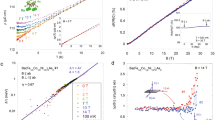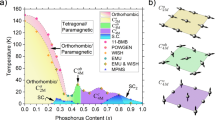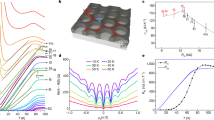Abstract
Many exotic metallic systems have a resistivity that varies linearly with temperature, and the physics behind this is thought to be connected to high-temperature superconductivity in the cuprates and iron pnictides1,2,3,4,5,6,7,8,9. Although this phenomenon has attracted considerable attention, it is unclear how the relevant physics manifests in other transport properties, for example their response to an applied magnetic field. We report measurements of the high-field magnetoresistance of the iron pnictide superconductor BaFe2(As1−xPx)2 and find that it obeys an unusual scaling relationship between applied magnetic field and temperature, with a conversion factor given simply by the ratio of the Bohr magneton and the Boltzmann constant. This suggests that magnetic fields probe the same physics that gives rise to the T-linear resistivity, providing a new experimental clue to this long-standing puzzle.
This is a preview of subscription content, access via your institution
Access options
Subscribe to this journal
Receive 12 print issues and online access
$259.00 per year
only $21.58 per issue
Buy this article
- Purchase on SpringerLink
- Instant access to full article PDF
Prices may be subject to local taxes which are calculated during checkout



Similar content being viewed by others
References
Bruin, J. A. N., Sakai, H., Perry, R. S. & Mackenzie, A. P. Similarity of scattering rates in metals showing T-linear resistivity. Science 339, 804–807 (2013).
Kasahara, S. et al. Evolution from non-Fermi- to Fermi-liquid transport via isovalent doping in BaFe2(As1−xPx)2 superconductors. Phys. Rev. B 81, 184519 (2010).
Takagi, H. et al. Systematic evolution of temperature-dependent resistivity in La2−xSrxCuO4 . Phys. Rev. Lett. 69, 2975–2978 (1992).
Cooper, R. A. et al. Anomalous criticality in the electrical resistivity of La2−xSrxCuO4 . Science 323, 603–607 (2009).
Varma, C. M., Littlewood, P. B., Schmitt-Rink, S., Abrahams, E. & Ruckenstein, A. E. Phenomenology of the normal state of Cu-O high-temperature superconductors. Phys. Rev. Lett. 63, 1996–1999 (1989).
Kivelson, S. A., Fradkin, E. & Emery, V. J. Electronic liquid-crystal phases of a doped mott insulator. Nature 393, 550–553 (1998).
Hartnoll, S. A. Theory of universal incoherent metallic transport. Nature Phys. 11, 54–61 (2015).
Sachdev, S. & Ye, J. Universal quantum-critical dynamics of two-dimensional antiferromagnets. Phys. Rev. Lett. 69, 2411–2414 (1992).
Phillips, P. & Chamon, C. Breakdown of one-parameter scaling in quantum critical scenarios for high-temperature copper-oxide superconductors. Phys. Rev. Lett. 95, 107002 (2005).
Borzi, R. A. et al. Formation of a nematic fluid at high fields in Sr3Ru2O7 . Science 315, 214–217 (2007).
Custers, J. et al. The break-up of heavy electrons at a quantum critical point. Nature 424, 524–527 (2003).
Marel, D. v. d. et al. Quantum critical behaviour in a high-Tc superconductor. Nature 425, 271–274 (2003).
Zaanen, J. Superconductivity: why the temperature is high. Nature 430, 512–513 (2004).
Butch, N. P., Jin, K., Kirshenbaum, K., Greene, R. L. & Paglione, J. Quantum critical scaling at the edge of Fermi liquid stability in a cuprate superconductor. Proc. Natl Acad. Sci. USA 109, 8440–8444 (2012).
Shekhter, A. et al. Bounding the pseudogap with a line of phase transitions in YBa2Cu3O6+δ . Nature 498, 75–77 (2013).
Ramshaw, B. J. et al. Quasiparticle mass enhancement approaching optimal doping in a high-Tc superconductor. Science 26, 317–320 (2015).
Kasahara, S. et al. Electronic nematicity above the structural and superconducting transition in BaFe2(As1−xPx)2 . Nature 486, 382–385 (2012).
Hashimoto, K. et al. A sharp peak of the zero-temperature penetration depth at optimal composition in BaFe2(As1−xPx)2 . Science 336, 1554–1557 (2012).
Dai, J., Si, Q., Zhu, J.-X. & Abrahams, E. Iron pnictides as a new setting for quantum criticality. Proc. Natl Acad. Sci. USA 106, 4118–4121 (2009).
Jiang, S. et al. Superconductivity up to 30 K in the vicinity of the quantum critical point in BaFe2(As1−xPx)2 . J. Phys. Condens. Matter 21, 382203 (2009).
Nakai, Y. et al. 31P and 75As NMR evidence for a residual density of states at zero energy in superconducting BaFe2(As0.67P0.33)2 . Phys. Rev. B 81, 020503 (2010).
Shishido, H. et al. Evolution of the Fermi surface of BaFe2(As1−xPx)2 on entering the superconducting dome. Phys. Rev. Lett. 104, 057008 (2010).
Walmsley, P. et al. Quasiparticle mass enhancement close to the quantum critical point in BaFe2(As1−xPx)2 . Phys. Rev. Lett. 110, 257002 (2013).
Analytis, J. G. et al. Transport near a quantum critical point in BaFe2(As1−xPx)2 . Nature Phys. 10, 194–197 (2014).
Analytis, J. G., Chu, J., McDonald, R. D., Riggs, S. C. & Fisher, I. R. Enhanced Fermi-surface nesting in superconducting BaFe2(As1−xPx)2 revealed by the de Haas–van Alphen effect. Phys. Rev. Lett. 105, 207004 (2010).
Pippard, A. B. Magnetoresistance in Metals (Cambridge Univ. Press, 2009).
Koshelev, A. E. Linear magnetoconductivity in multiband spin-density-wave metals with nonideal nesting. Phys. Rev. B 88, 060412(R) (2013).
Fenton, J. & Schofield, A. J. Breakdown of weak-field magnetotransport at a metallic quantum critical point. Phys. Rev. Lett. 95, 247201 (2005).
Rosa, P. F. S. et al. Possible unconventional superconductivity in substituted BaFe2As2 revealed by magnetic pair-breaking studies. Sci. Rep. 4, 6252 (2014).
Weickert, F., Gegenwart, P., Ferstl, J., Geibel, C. & Steglich, F. Low-temperature electrical resistivity of Yb1−xLaxRh2Si2 . Physica B 378–380, 72–73 (2006).
Acknowledgements
I.M.H. and N.P.B. acknowledge support from the Laboratory Directed Research and Development Program of Lawrence Berkeley National Laboratory under the US Department of Energy Contract No. DE-AC02-05CH11231. T.H. was supported by the Quantum Materials FWP, US Department of Energy, Office of Basic Energy Sciences, Materials Sciences and Engineering Division, under Contract No. DE-AC02- 05CH11231. A portion of this work was supported by the Gordon and Betty Moore Foundations EPiQS Initiative through Grant GBMF4374. A portion of this work was completed at the National High Magnetic Field Laboratory’s Pulsed Field Facility at Los Alamos National Laboratory, which is supported through National Science Foundation Cooperative Agreement No. DMR 1157490 and the Department of Energy. R.D.M. acknowledges US DOE BES-Science of 100 Tesla. The authors extend their gratitude to the scientific and technical support staff of the NHMFL Pulsed Field Facility, particularly B. J. Ramshaw and the 100 Tesla operations team. The authors also thank S. Kivelson, P. Coleman, D. Maslov, A. Chubukov and P. Phillips for helpful discussions.
Author information
Authors and Affiliations
Contributions
I.M.H., J.G.A., A.S. and R.D.M. conceived the experiment and performed the analysis. I.M.H., T.H. and J.G.A. synthesized the samples. I.M.H., J.G.A., R.M.D., M.W., T.H. and N.P.B. performed the measurements at high magnetic fields. P.J.W.M. prepared the overdoped samples for transport measurements. All authors participated in the writing of the manuscript.
Corresponding author
Ethics declarations
Competing interests
The authors declare no competing financial interests.
Supplementary information
Supplementary information
Supplementary information (PDF 4375 kb)
Rights and permissions
About this article
Cite this article
Hayes, I., McDonald, R., Breznay, N. et al. Scaling between magnetic field and temperature in the high-temperature superconductor BaFe2(As1−xPx)2. Nature Phys 12, 916–919 (2016). https://doi.org/10.1038/nphys3773
Received:
Accepted:
Published:
Issue date:
DOI: https://doi.org/10.1038/nphys3773
This article is cited by
-
Giant magnetoresistance of Dirac plasma in high-mobility graphene
Nature (2023)
-
Interplay between superconductivity and the strange-metal state in FeSe
Nature Physics (2023)
-
Anomalous enhancement of the Nernst effect at the crossover between a Fermi liquid and a strange metal
Nature Physics (2023)
-
Anisotropic positive linear and sub-linear magnetoresistivity in the cubic type-II Dirac metal Pd3In7
npj Quantum Materials (2023)
-
Mixed-state entanglement for AdS Born-Infeld theory
Journal of High Energy Physics (2023)



